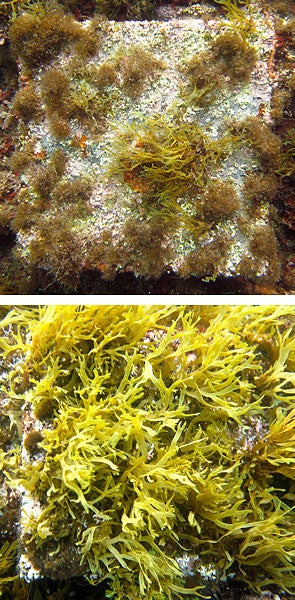|
September 12, 2012
Ocean acidification and interspecies competition could transform ecosystems, Stanford research shows
Hard-shelled marine creatures that are threatened by the ocean's ongoing acidification might also face pressure from other species, according to new work by a Stanford biologist. By Bjorn Carey

In the top image, a sample tile shows algae growth in ambient seawater conditions. The bottom image shows increased algae growth in an area with acidity levels close to those predicted for 2100. (Photos: Kristy Kroeker / Courtesy of Stanford University)
One of the greatest threats to wildlife on the planet is the ongoing acidification of the ocean. As acidity rises, there is also less carbonate available in the ocean, which makes life difficult for hard-shelled creatures.
New research by Stanford scientists shows that this relationship might not be as straightforward as previously believed, and that species not impaired by acidic water might be playing an active role in reducing the numbers of those that rely on calcium carbonate.
There's no doubt that ocean acidity is changing.
"The oceans have absorbed 30 to 40 percent of the CO2 that has been emitted into the atmosphere since the industrial revolution, and this causes very predictable changes in the ocean's chemistry," said Kristy Kroeker, a biology researcher at Stanford's Hopkins Marine Station. "It's very straightforward chemistry that makes the water become more acidic."
The most concerning chemical change is an ocean-wide reduction in carbonate ions, a molecule that many marine organisms – clams, mussels, oysters, snails, barnacles, coral, and so on – draw from the water to build their calcium carbonate shells or skeletons. Scientists broadly predict that as the carbonate concentration decreases, so too will populations of these calcareous animals; this theory has been borne out in lab experiments and, to a lesser degree, field observations.
But most research into the effects of this change has focused on single species isolated in tanks of varying acidity. Kroeker traded tanks and mechanical bubblers for a small patch of reef in the Mediterranean Sea. Off the island of Ischia, just west of Naples, Italy, naturally occurring underwater CO2 vents create zones of varying acidity, and Kroeker has observed how various species fare with that chemical change as well as how the animals interact with one another.
In previous studies at this vent and others like it, scientists saw that increased acidity corresponded with a decrease in the number of calcareous species, and broadly assumed that the chemical stress made it difficult for these animals to gain a foothold in the challenging environment.
Kroeker found that in zones of both high and low acidity, larvae of calcareous species such as barnacles and pink coralline algae arrive and grow at very similar rates. But midway through this succession, a fleshy turf algae arrives, and in the high-acidity zones – which, for the purpose of this study represent the overall acidity of the world's oceans in the year 2100 – begins to take over.
"If you were to snorkel on these vents, you would see all this colorful pink coralline algae," Kroeker said. "But as you move into an acidified region, it's all fleshy algae. It's a green fuzz that grows on everything."
The study was published online at Nature Climate Change.
The algae fares extremely well in highly-acidic circumstances – previous research suggests that some fleshy algae photosynthesize better in high-carbon dioxide conditions – and it overgrows the calcareous species.
It's currently unclear why exactly the algae is able to beat out other species. It might just grow better in the high CO2 conditions or it's possible that adult calcareous species graze less in high acidity and eat less of the seaweed, allowing it to grow unchecked. But the overall outcome is a potentially dangerous reduction in biodiversity.
"Less diverse ecosystems are typically less able to cope with stress," Kroeker said. For example, if a heat wave knocks out one species, it can affect any species that it interacts with. In a region of high biodiversity, those species, be they predator or prey, typically have other options to turn to. "Low diversity systems don't weather the storm as well."
It's difficult to apply the findings from one small patch of reef to the entire ocean, Kroeker said, but the implications of this work run beyond simply ruining popular snorkeling spots. Fleshy seaweeds are vying for space in several ecosystems, including coral reefs and kelp forests. If the trend observed in Ischia is repeated in other parts of the world, then similar changes could occur as the ocean becomes more acidic. And these changes could threaten more than just clams and coral.
"These ecosystems provide habitat and food sources for fish," Kroeker said. "In general, as food availability for fish declines, so does the amount of those fish."
The only way to stop ocean acidification, Kroeker said, is to reduce the amount of carbon dioxide in the atmosphere, which, because it must occur on a global scale and is complicated by politics and economics, is a daunting task. However, changes made at the local level could stave off a loss of biodiversity.
"Since our research suggests that ocean acidification favors fleshy seaweeds, management actions that protect the animals that eat fleshy seaweed (mainly fish and urchins) and limit the amount of local pollution could potentially slow the ecosystem changes," Kroeker said.
-30-
|